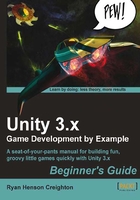
Toy or story
The approach that we're taking to your initial idea phase is not an approach that comes naturally. Usually, new game developers want to start with setting, story, and character, as if writing a book. That's how we've always been taught to begin a creative project. As there's often so much overlap between narrative forms like books, movies, and TV shows, it's tempting to start there. "My game is about a dark, brooding superwarrior named Kane Glorg who doesn't know who his parents are, so he travels the wasted landscape with his two-handed axe and his vicious battle sloth, slicing through hordes of evil slime demons in his ultimate quest to punch Satan in the face."
The take-away from this chapter is that all that stuff is window dressing. When you're just starting out - and unless you're building an explicitly narrative game like a graphic or textbased adventure - story, setting, or character will be the end point, not the start point. Too many would-be game developers get caught up in the epic implications of their story design instead of worrying about what's most important: does my game have a fun, simple mechanic that players will enjoy?
When you're designing a game, you're not creating a narrative. You're creating a toy, which can be wrapped like a sausage roll in flaky layers of delicious storytelling, character arcs, and twist endings, but you need to start with the toy. You need to start with that small, singular piece of joy that puts a smile on your player's face. As Shigeru Miyamoto, the man who created Mario, Donkey Kong, and Zelda, said in his 2007 keynote at the Game Developers Conference, start by imagining your player having fun with your game, and work backwards from there.
Tip
Shopping for ideas
One great place to find inspiration for games is your local toy store. Ignore the toy skins, like the high-seas adventure of Lego Pirates sets, and focus on the mechanic: building. Ignore the giant fire-breathing scorpion head skin on that Hot Wheels track set, and think about the mechanic: the fun, physical way the little cars fly over the ramps. And be sure to investigate the small, simple toys in the end aisles, in the nickel bins, and inside those chocolate eggs and bags of caramel popcorn. You're bound to find game mechanic ideas there.
Pop Quiz – Finding that singular piece of joy
What follows is a list of video games that are all based on a real-world physical game mechanic. In some cases, they're based on a physical game, and in other cases, they're based on goofing around. Can you identify the singular piece of joy from which these games take their cue? The answers are written on a folded piece of paper that I've hidden underneath your chair.
- Super Monkey Ball: Tilt the level to guide a sphere along ramps, spirals, and treacherously thin platforms suspended above a bottomless void.
- Metal Gear Solid: Hide behind crates and other pieces of cover while heavily armed guards seek you.
- Boom Blox: Throw a ball at a stack of blocks that have different physical properties to knock them all down or to make them explode.
- Katamari Damacy: Roll a ball around in random detritus scattered around the level and watch it grow ever larger. Roll up a writhing junk wad of sufficient size to reach the goal.
- Dance Dance Revolution: Light up a series of scrolling arrows by stepping on their corresponding buttons on a flat input pad. The button presses are timed to the beat of a backing soundtrack.